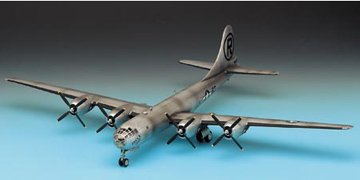
Between February 18th and November 1st, 1944, the newly designated 509th Composite Group underwent extremely thorough training dropping very large single test bombs from high altitude while maintaining maximum accuracy. This program was undertaken at Wright Field, Muroc and Wendover Air Bases and utilized a total of 45 modified B-29A aircraft. Its purpose was to provide a ready-made delivery system for the atomic bomb which was still in its developments stage as part of the Manhattan Project. By the time the first atomic bomb was exploded at Alamogordo, New Mexico on July 16th, 1945, the 393rd Bombardmetn Squadron, a part of the 509th, was stationed on Tinian Island in the Marianas and had practiced high-altitude bombing techniques against the Japanese Islands using normal high-explosive bombs. When President Truman made the decision to use the atomic bomb to end the war in the Pacific, the first two atomic bombs, Little Boy and Fat Man were rushed to Tinian on board a Navy cruiser. On August 6th, 1945, the ENOLA GAY and a flight of 6 other B-29 aircraft commanded by Colonel Paul W. Tibbets Jr.made the first atomic bombing raid against the target city Hiroshima. The 9,700 pound Little Boy weapon was dropped from 31,600 feet and exploded 800 feet above the aiming point. In an instant 4.7 square miles of Hiroshima was no more. Despite the shock the first atomic bomb had on the Japanese leadership, it took one more atomic bombing raid on Nagaski using the Fat Man bomb to push Japan into surrender. Features: Fully engraved panel lines, Highly Detailed cockpit interior & bomb bay, and Optional position landing gear and bomb bay door. Paint colors needed: Aluminum, Flat Black, Flat Interior Green, Flat Tan, Flat Metallic Grey, Flat Yellow, Flat Burnt Metal, Flat Grey, Flat Aluminum, Flat Red, Flat Blue, Flat Orange, Flat Light Grey, Gloss Silver, Gloss White, and Gloss Gun Metal.


No comments:
Post a Comment